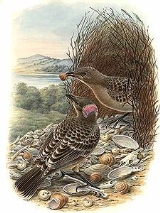
Great Bowerbird
Encyclopedia
The Great Bowerbird, Chlamydera nuchalis is a common and conspicuous resident of northern Australia
, from the area around Broome
across the Top End
to Cape York Peninsula
and as far south as Mount Isa
. Favoured habitat is a broad range of forest and woodland, and the margins of vine forests, monsoon forest, and mangrove
swamps.
As with most members of the bowerbird family
, breeding considerations dominate the lifecycle: females nest inconspicuously and raise their young alone, while the males spend most of the year building, maintaining, improving, defending, and above all displaying from their bowers. Only a male with a successful bower can attract mates.
The Great Bowerbird is the largest of the bowerbird family and is 33 to 38 cm long and fawny grey in colour. Males have a small but conspicuous pink crest on the nape of the neck.
Uniquely among bowerbirds, groups of young males will attend a single bower concurrently, "practising" their bower-building skills prior to establishing their own bower for mating purposes.
Australia
Australia , officially the Commonwealth of Australia, is a country in the Southern Hemisphere comprising the mainland of the Australian continent, the island of Tasmania, and numerous smaller islands in the Indian and Pacific Oceans. It is the world's sixth-largest country by total area...
, from the area around Broome
Broome, Western Australia
Broome is a pearling and tourist town in the Kimberley region of Western Australia, north of Perth. The year round population is approximately 14,436, growing to more than 45,000 per month during the tourist season...
across the Top End
Top End
The Top End of northern Australia is the second northernmost point on the continent. It covers a rather vaguely-defined area of perhaps 400,000 square kilometres behind the northern coast from the Northern Territory capital of Darwin across to Arnhem Land with the Indian Ocean on the west, the...
to Cape York Peninsula
Cape York Peninsula
Cape York Peninsula is a large remote peninsula located in Far North Queensland at the tip of the state of Queensland, Australia, the largest unspoilt wilderness in northern Australia and one of the last remaining wilderness areas on Earth...
and as far south as Mount Isa
Mount Isa, Queensland
-Culture and sport:The local theatre group, the Mount Isa Theatrical Society, or MITS, often holds plays and musicals, at least once every few months or so....
. Favoured habitat is a broad range of forest and woodland, and the margins of vine forests, monsoon forest, and mangrove
Mangrove
Mangroves are various kinds of trees up to medium height and shrubs that grow in saline coastal sediment habitats in the tropics and subtropics – mainly between latitudes N and S...
swamps.
As with most members of the bowerbird family
Bowerbird
Bowerbirds make up the bird family Ptilonorhynchidae. The family has 20 species in eight genera. These are medium-sized passerines, ranging from the Golden Bowerbird to the Great Bowerbird...
, breeding considerations dominate the lifecycle: females nest inconspicuously and raise their young alone, while the males spend most of the year building, maintaining, improving, defending, and above all displaying from their bowers. Only a male with a successful bower can attract mates.
The Great Bowerbird is the largest of the bowerbird family and is 33 to 38 cm long and fawny grey in colour. Males have a small but conspicuous pink crest on the nape of the neck.
The Bower
The male builds the largest bower of all bowerbirds. It is a twin-walled avenue-type bower approximately 1 metre long and 45cm high. It is typically located under a shrub or leafy branch. The ends of the bower are scattered with white and green objects - stones, bones, shells and leaves and small man-made objects such as plastic and bottle caps. Within the bower itself is sometimes placed clear glass.Uniquely among bowerbirds, groups of young males will attend a single bower concurrently, "practising" their bower-building skills prior to establishing their own bower for mating purposes.

